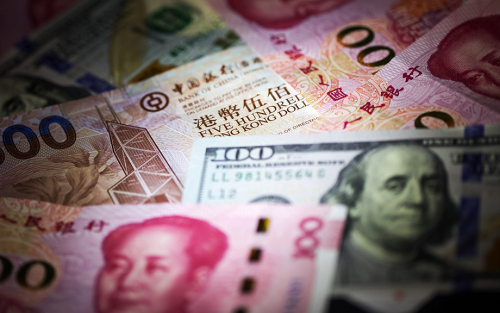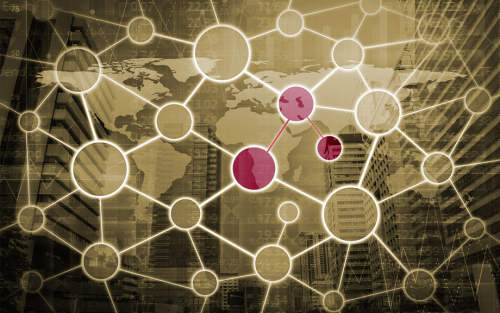Have the Fed Swap Lines Reduced Dollar Funding Strains during the COVID‑19 Outbreak?

In March 2020, the Federal Reserve made changes to its swap line facilities with foreign central banks to enhance the provision of dollars to global funding markets. Because the dollar has important roles in international trade and financial markets, reducing these strains helps facilitate the supply of credit to households and businesses, both domestically and abroad. This post summarizes the changes made to central bank swap lines and shows that these changes were effective at bringing down dollar funding strains abroad.
The Paycheck Protection Program Liquidity Facility (PPPLF)

On April 9, 2020, the Federal Reserve announced that it would take additional actions to provide up to $2.3 trillion in loans to support the economy in response to the COVID-19 crisis. Among the measures taken was the establishment of a new facility intended to facilitate lending to small businesses via the Small Business Administration’s Paycheck Protection Program (PPP). Under the Paycheck Protection Program Liquidity Facility (PPPLF), Federal Reserve Banks are authorized to supply liquidity to financial institutions participating in the PPP in the form of term financing on a non-recourse basis while taking PPP loans as collateral. The facility was launched April 16, 2020. As of May 7, it had issued over $29 billion in loans (see the H.4.1 Statistical Release). This post lays out the background for the PPPLF and discusses its intended effects.
Modeling the Global Effects of the COVID‑19 Sudden Stop in Capital Flows

The COVID-19 outbreak has triggered unusually fast outflows of dollar funding from emerging market economies (EMEs). These outflows are known as “sudden stop” episodes, and they are typically followed by economic contractions. In this post, we assess the macroeconomic effects of the COVID-induced sudden stop of capital flows to EMEs, using our open-economy DSGE model. Unlike existing frameworks, such as the Federal Reserve Board’s SIGMA model, our model features both domestic and international financial constraints, making it well-suited to capture the effects of an outflow of dollar funding. The model predicts output losses in EMEs due in part to the adverse effect of local currency depreciation on private-sector balance sheets with dollar debts. The financial stresses in EMEs, in turn, spill back to the U.S. economy, through both trade and financial channels. The model-predicted output losses are persistent (consistent with previous sudden stop episodes), with financial effects being a significant drag on the recovery. We stress that we are only tracing out the effects of one particular channel (the stop of capital flows and its associated effect on funding costs) and not the totality of COVID-related effects.
Does the BCG Vaccine Protect Against Coronavirus? Applying an Economist’s Toolkit to a Medical Question

As COVID-19 has spread across the globe, there is an intense search for treatments and vaccines, with numerous trials running in multiple countries. Several observers and prominent news outlets have noticed that countries still administering an old vaccine against tuberculosis—the Bacillus Camille-Guerin (BCG) vaccine—have had fewer coronavirus cases and fewer deaths per capita in the early stages of the outbreak. But is that correlation really strong evidence that the BCG vaccine provides some defense against COVID-19? In this post, we look at the incidence of coronavirus cases along the former border between East and West Germany, using econometric techniques to investigate whether historical differences in vaccination policies account for the lower level of infection in the former East.
How Does Supervision Affect Bank Performance during Downturns?

New research finds that there is a cyclical nature to the benefits of bank supervisory attention: in normal times, the benefits are smaller, but during downturns the more closely supervised banks exhibit better loan performance and lower earnings volatility.
Fight the Pandemic, Save the Economy: Lessons from the 1918 Flu

The COVID-19 outbreak has sparked urgent questions about the impact of pandemics, and the associated countermeasures, on the real economy. Policymakers are in uncharted territory, with little guidance on what the expected economic fallout will be and how the crisis should be managed. In this blog post, we use insights from a recent research paper to discuss two sets of questions. First, what are the real economic effects of a pandemic—and are these effects temporary or persistent? Second, how does the local public health response affect the economic severity of the pandemic? In particular, do non-pharmaceutical interventions (NPIs) such as social distancing have economic costs, or do policies that slow the spread of the pandemic also reduce its economic severity?
Did Subprime Borrowers Drive the Housing Boom?

The role of subprime mortgage lending in the U.S. housing boom of the 2000s is hotly debated in academic literature. One prevailing narrative ascribes the unprecedented home price growth during the mid-2000s to an expansion in mortgage lending to subprime borrowers. This post, based on our recent working paper, “Villains or Scapegoats? The Role of Subprime Borrowers in Driving the U.S. Housing Boom,” presents evidence that is inconsistent with conventional wisdom. In particular, we show that the housing boom and the subprime boom occurred in different places.
Once Upon a Time in the Banking Sector: Historical Insights into Banking Competition

How does competition among banks affect credit growth and real economic growth? In addition, how does it affect financial stability? In this blog post, we derive insights into this important set of questions from novel data on the U.S. banking system during the nineteenth century.
How Large Are Default Spillovers in the U.S. Financial System?

When a financial firm suffers sufficiently high losses, it might default on its counterparties, who may in turn become unable to pay their own creditors, and so on. This “domino” or “cascade” effect can quickly propagate through the financial system, creating undesirable spillovers and unnecessary defaults. In this post, we use the framework that we discussed in “Assessing Contagion Risk in a Financial Network,” the first part of this two-part series, to answer the question: How vulnerable is the U.S. financial system to default spillovers?
Assessing Contagion Risk in a Financial Network

Duarte, Jones, and Ruela describe how stress can propagate through the financial system and sketch out an approach for quantifying economic losses stemming from default cascades.










 RSS Feed
RSS Feed Follow Liberty Street Economics
Follow Liberty Street Economics